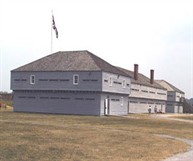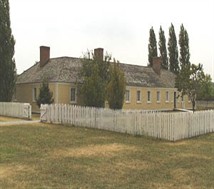Reconstructed Sites and Heritage Value
The role of the heritage community has been invaluable in
increasing knowledge pertaining to national historic sites.
Historical and archaeological research has been vital in
identifying why a site is important and its special
characteristics. Decisions made by the heritage community can also
alter the narrative of a site in significant ways. In some cases
this narrative in itself holds value. This becomes evident when
considering a number of early national historic site
reconstructions in Canada. Many have been determined to now have
heritage value both for their historic value and as representations
of early conservation practice in Canada.
Following the example of U.S. President Roosevelt's New Deal,
the Canadian Federal Government passed the Public Works
Construction Act in 1934. Despite the weak economy, this supplied
large sums of money that were used to finance large scale
reconstruction projects at both the national and provincial level;
these would create jobs and could generate tourism, thereby
reinvigorating economically depressed areas. The economic success
and popularity of reconstructed sites south of the border, such as
Fort Ticonderoga on Lake Champlain recreated in 1907 and Colonial
Williamsburg opened in 1933, encouraged similar projects here at
home. An increase in the number of professional archaeologists and
historians across Canada created confidence that enough data could
be recovered to accurately recreate heritage sites, though this was
not always the case.
In 1917 the military reserve in Annapolis Royal Nova Scotia, Fort Anne, became a Dominion Park under the
Department of the Interior. It had been protected locally since
1886 when railway expansion brought to light its merit in the
emerging tourism industry. The Fort had played an important role in
early European colonization, settlement and government in Acadia
and Nova Scotia in the 17th and 18th centuries and was the centre
of changing social, political and military relations among the
Mi'kmaq, the Acadians and the British living in the area. In
1934-35 the British officers' quarters was ruthlessly restored to
such an extent as to now be considered reconstructed. The old
wooden barracks was transformed into an attractive and efficient
museum, the wood framing being replaced with poured concrete. In
1984 a management-plan recommendation was tabled to return the
exterior and parts of the interior to a conjectural 1835
appearance. The proposal was submitted to the Federal Heritage
Building Review Office in 1988 where the building was recognized
for its importance as an excellent example of early conservation.
The proposed plan was not implemented as it would have obliterated
the very features of the building that made it worth
preserving. 
Fort George National Historic Site was
originally built by the British in 1796-99. Located in
Niagara-on-the-Lake, Ontario, it served as the
principal fortification on the Niagara Peninsula during the War of
1812 and was destroyed by the Americans in 1813. Because of its
historic value, it was designated a National Historic Site in
October 1920. Fort George was later reconstructed as a make-work
project under the Niagara Parks Commission. The reconstruction was
inaccurate because many  decisions were made to
accommodate practical requirements and to appeal to a romanticized
view rather than the controlled, orderly Georgian reality. The
architect overseeing the project identified and tried to correct
inaccuracies but to no avail. In 1991 the site was reviewed and
this new narrative was deemed worthy of commemoration.
decisions were made to
accommodate practical requirements and to appeal to a romanticized
view rather than the controlled, orderly Georgian reality. The
architect overseeing the project identified and tried to correct
inaccuracies but to no avail. In 1991 the site was reviewed and
this new narrative was deemed worthy of commemoration.
These sites serve as excellent examples of a single site having
many different narratives and of the importance of valuing the
entire history of a site. The history of the heritage effort itself
has value.